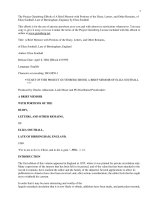Symptoms and Diagnosis of Kidney and Urinary Tract potx
Bạn đang xem bản rút gọn của tài liệu. Xem và tải ngay bản đầy đủ của tài liệu tại đây (17.07 KB, 8 trang )
Symptoms and Diagnosis of Kidney
and Urinary Tract
Some urinary tract disorders rarely cause symptoms until the problem is very
advanced; these include kidney failure, tumors and stones that do not block urine
flow, and some low-grade infections. Sometimes, symptoms occur but are very
general and difficult for the doctor to connect to the kidney. For example, a
general feeling of illness (malaise), loss of appetite, nausea, or generalized itching
may be the only symptoms of chronic kidney failure. In older people, mental
confusion may be the first recognized symptom of infection or kidney failure.
Symptoms that are more suggestive of a kidney or urinary problem include pain in
the side (flank), swelling of the lower extremities, and problems with urination.
BURNING OR PAIN WITH URINATION
Burning or pain with urination (dysuria) may be felt at the opening to the urethra
or, less often, over the bladder (in the pelvis, the lower part of the abdomen just
above the pubic bone). Occasionally, if a woman has vaginal irritation (for
example, due to inflammation or infection of the vagina or of the area surrounding
the vaginal opening, called vulvovaginitis), she may feel a burning sensation when
urinating.
Causes
Dysuria is very common, particularly among adult women, in whom it is often
caused by urinary tract infections, such as cystitis and urethritis. However, dysuria
can occur in men and women of any age and can have many noninfectious causes.
Common Causes of Dysuria
Type
Examples
Infectious*
Cervicitis
Cystitis (more common in women)
Epididymo-orchitis
Prostatitis
Urethritis
Vulvovaginitis
Inflammatory
Inflammatory connective tissue disorders (reactive arthritis or Behçet's syndrome)
Interstitial cystitis (noninfectious bladder inflammation)
Vulvar vestibulitis (increased vulvar sensitivity to pain)
Physical
Catheterization of the bladder
Obstruction of the bladder neck (for example, due to benign prostatic hyperplasia)
or urethra (due to strictures)
Other
Atrophic vaginitis or urethritis
Tumors
*Common infectious organisms include nonsexually transmitted bacteria
(mostlyEscherichia coli) and sexually transmitted organisms (such as those that
cause gonorrhea, chlamydial infection, and trichomoniasis).
Evaluation
Doctors can sometimes get clues to the cause based on where symptoms are most
severe. For example, if symptoms are most severe just above the pubic bone, a
bladder infection (cystitis) may be the cause. Women with frequent episodes of
cystitis may recognize characteristic symptoms that suggest another episode. If
symptoms are most severe at the opening of the urethra, urethritis may be the
cause. In men with a penile discharge, urethritis is often the cause. If burning
affects mainly the vagina and the woman has a discharge, vaginitis may be the
cause.
Examination may confirm a condition that could be causing dysuria. For example,
vaginal or penile discharge can be confirmed. Inflammation or atrophy of the
vagina or vulva may confirm vulvovaginitis. An enlarged prostate may confirm
benign prostatic hyperplasia. Tenderness of the epididymis or testes may suggest
epididymo-orchitis, and tenderness of the prostate may suggest prostatitis.
Doctors do not always agree on the need for tests. Some doctors just treat adult
women who have symptoms that suggest cystitis. Other doctors usually do testing
for all people or for people in whom the diagnosis is not clear. The first test is
usually a urinalysis. Urine culture is often done to identify the organism causing
infection and to determine which antibiotics will be effective. For women, a
sample of vaginal discharge is examined on a slide using a microscope. Men and
women with a urethral discharge are tested for gonorrhea and chlamydia.
Treatment
The cause is treated. Often, the cause is an infection, and treatment produces relief
in 1 or 2 days. If dysuria is severe, phenazopyridine
can be taken for the first 2 days to relieve discomfort. Phenazopyridine
turns the urine a red-orange color.
SWELLING
Swelling results from accumulation of fluid in the tissues (edema). The swelling
may cause weight gain. Swelling is usually most noticeable in the ankles and feet,
but it may also involve the abdomen, lower back, hands, and face. If swelling is
particularly severe, fluid may accumulate in the lungs, causing difficulty
breathing.
Causes
Swelling may occur if the kidneys are unable to excrete excess water and sodium
from the body, as in kidney failure. Swelling may also develop from a kidney
disorder that causes the loss of large amounts of blood protein (especially
albumin) in the urine (nephrotic syndrome). When the albumin level in the blood
drops sufficiently, swelling occurs as fluid leaks from the circulation into the
tissues.
Other disorders may also cause swelling. Heart failure, caused by inadequate
pumping by the heart, signals the kidneys to retain salt and fluid, which may
accumulate in tissues. Advanced liver disease also signals the kidneys to retain salt
and fluid; swelling is worsened by the reduction in blood protein that occurs. This
protein decrease causes fluid to leak into the tissues. If swelling occurs in only one
limb, the cause is probably something related to the limb (such as a blood clot in a
vein or an injury) rather than a kidney, heart, or liver problem.
Evaluation and Treatment
Doctors usually assess the presence and degree of swelling by pressing on the
person's shins. If the skin retains the impression of the doctor's finger, extra fluid
is present. The person's symptoms and the doctor's physical examination suggest
whether the kidneys, liver, or heart is the cause, but doctors also obtain a
urinalysis and blood tests of liver and kidney function. If heart failure is suspected,
a chest x-ray and sometimes an echocardiogram are obtained. To diagnose
nephrotic syndrome, doctors may assess urinary loss of protein by calculating the
ratio of total protein to creatinine in a urine specimen.
The underlying disorder is treated when possible. Swelling can often be relieved
by a diuretic if the kidneys are working properly. If the kidneys are not working
properly and fluid has collected in the lungs, the person may need dialysis.
INCREASED URINATION
Most people urinate about 4 to 6 times a day, mostly in the daytime. Normally,
adults pass between 3 cups (700 milliliters) and 2 quarts (2 liters) of urine a day.
Infants may pass as little as 1 cup (230 milliliters) per day. Urination can be
increased if a person produces an excess volume of urine or produces a normal
volume of urine but feels the need to go more often (urinary frequency).
Causes
Increased Volume: Excess urine can be caused by drinking too much fluid
(polydipsia), by taking diuretic drugs or substances that have a diuretic effect, such
as alcohol or caffeine, or by having a high level of sugar in the blood (as in
diabetes mellitus). A rare condition called diabetes insipidus causes excess urine
because of problems with a brain hormone called antidiuretic hormone (also called
vasopressin). Antidiuretic hormone helps the kidney reabsorb fluid. If too little
antidiuretic hormone is produced (a condition called central diabetes insipidus) or
if the kidney is unable to properly respond to it (nephrogenic diabetes insipidus),
the person urinates excessively.
Increased Frequency: A frequent need to urinate without an increase in the total
daily output of urine can occur when something irritates or presses on the bladder.
A urinary tract infection (UTI) is the most common cause of bladder irritation.
Rarer causes include a stone or tumor in the bladder. A tumor or other mass (or
even the uterus if a woman is pregnant) pressing on the outside of the bladder can
also cause a frequent urge to urinate because the mass reduces the capacity of the
bladder. An inability to fully empty the bladder because of partial obstruction,
often from an enlarged prostate (in men), can produce frequency.
Evaluation and Treatment
The doctor asks about the use of diuretics. Symptoms such as pain or burning may
indicate infection. For men, the doctor will examine the prostate by putting a
gloved, lubricated finger in the man's rectum. If the prostate is enlarged, a blood
test (prostate specific antigen, or PSA, test) and sometimes a prostate ultrasound
are done. The doctor usually checks the urine for glucose (suggesting diabetes
mellitus) and bacteria or excess white blood cells (indicating infection). If the
cause is not clear, the doctor may measure levels of electrolytes in the blood and
urine and sometimes perform imaging tests of the kidney, ureters, or bladder (such
as CT, ultrasound, or magnetic resonance imaging [MRI]).









